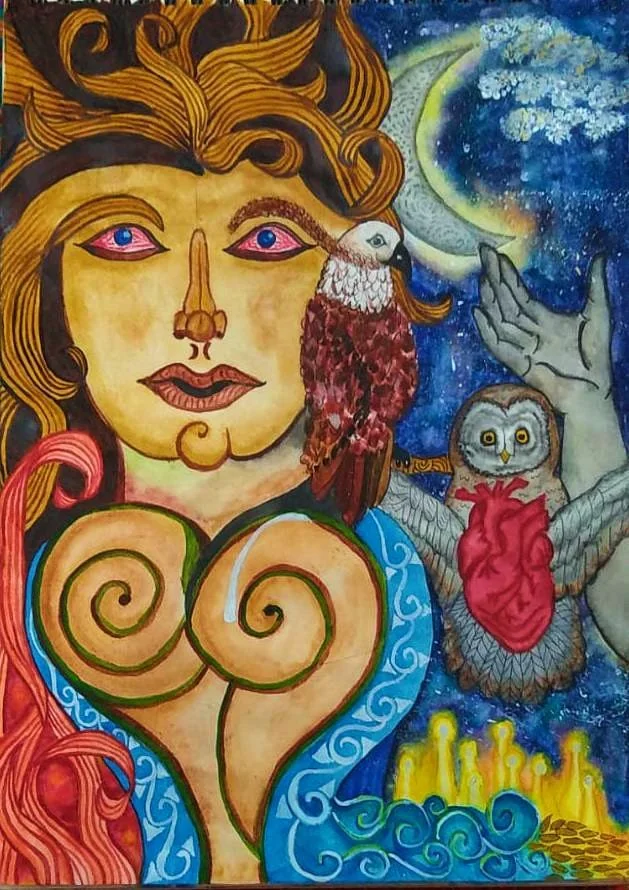Kabir Ghosh - "Shankhamala"
Kabir Ghosh
Delhi Public School, Sector 45, Gurgaon
Shankhamala
“This painting ‘Shankhamala’ is inspired by a Bengali poem of the same name by the celebrated poet Jibanananda Das and my childhood memories. It is a surrealist expression of my young imagination and the burst of different colours and elements symbolise the celebration of my identity. Shankhamala is a mythical name of a princess from Bengali fairy tales which literally means a necklace of conch shells (Shankha meaning conch shell and mala meaning necklace). In the poem, Shankhamala stands as an allegory of women who have suffered from pain and have been wronged through centuries.
This poem was recited and explained to me by my grandmother who taught me Bengali literature, my mother tongue. The enigmatic metaphors of the poem instantly struck my imagination and it became my favourite poem. Its imagery set off an artistic desire to translate the poem into a painting. This painting celebrates my identity and youth as it represents my favourite poem from my mother tongue. My Bengali heritage and love for its literature form a huge part of my identity and it is intrinsically attached to my youth since I learnt reading and writing the language in my young days. No talk about my attachment to Bengali is worth without describing the memories of my grandmother sitting down with me in afternoons and teaching it to me. This poem not only represents my identity and love for literature but encapsulates my childhood days of learning Bengali from my loving grandmother, connection to my roots and all the vivid imaginations the language used to set off in my young mind.
The background of the painting (right-hand side) is the starry dusk where the poet is on the lookout for Shankhamala. He looks for her in the constellations, the fog resembling wings and in the light falling from the bodies of fireflies on the river which flows on to become lush paddy (right-hand side bottom). He has looked for Shankhamala like the soul of a restless lonely owl in the Bengali month of Aghraan, when the darkness of the sky seems to be merging with the wings of grey owls (the owl in right-hand side centre represents the darkness of Aghraan and its heart the soul of the restless poet). The poet describes Shankhamala as a corpse having painful blue eyes yet red like burning wood. Her body is like the colour of a sad bird on a branch whose only listener is the crescent moon near its head [I chose to paint the Shankha chil bird (the Brahminy Kite Eagle, called so because of its Shankh like white neck) to depict this bird filling its colours in her body, as an ode to Shankhamala’s name]. Shankhamalas corpse’s face is white and cold and is burning on a pyre. Her eyes have the darkness and agony of a hundred centuries. Her breasts are like delicate conch shells wet with milk (referring to an old practice of washing conch shells with milk). Her pain is as real as any hurt woman’s but it’s still a secret and she’s like a magical woman from a fairy tale. The world only gets a woman like her once. I have represented conch shells in the shape of her breasts and in the borders of her sari through means of a traditional Aalpona (floor painting) pattern called Shankhalata, a creeper of conch shells. Her sari flows onto to become one with the river. The hand symbolises the poet’s longing for Shankhamala and is reaching out to the meaning in hope of finding her. It is dark in colour to symbolise the theme of death and the past in the poem.”

